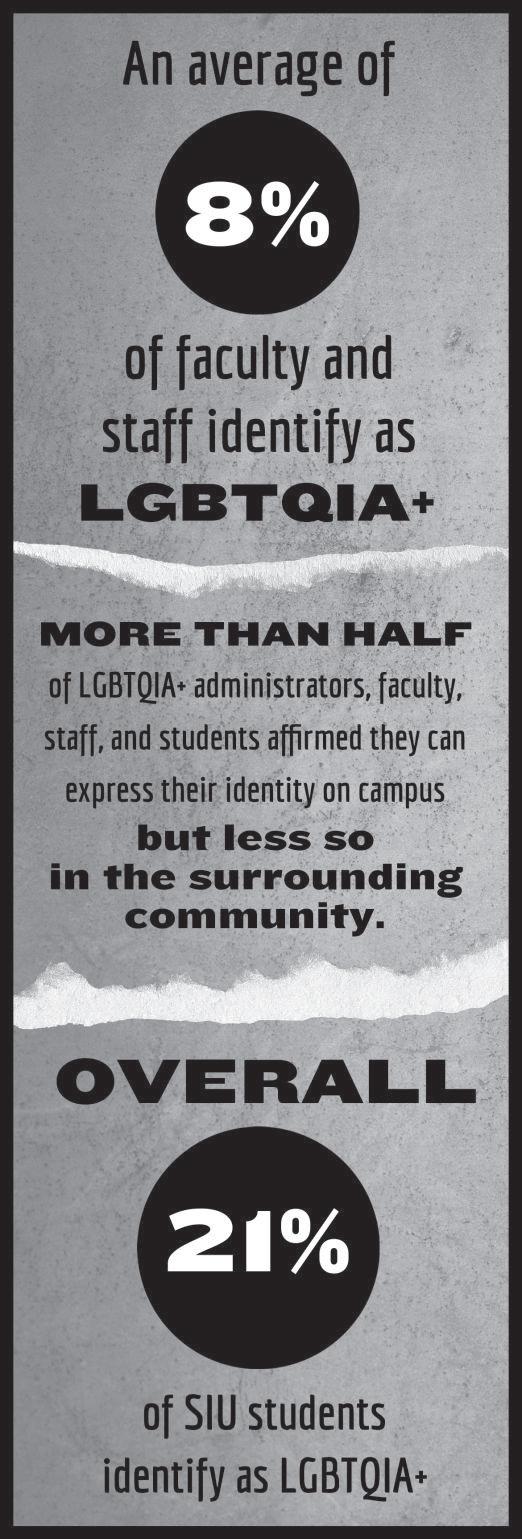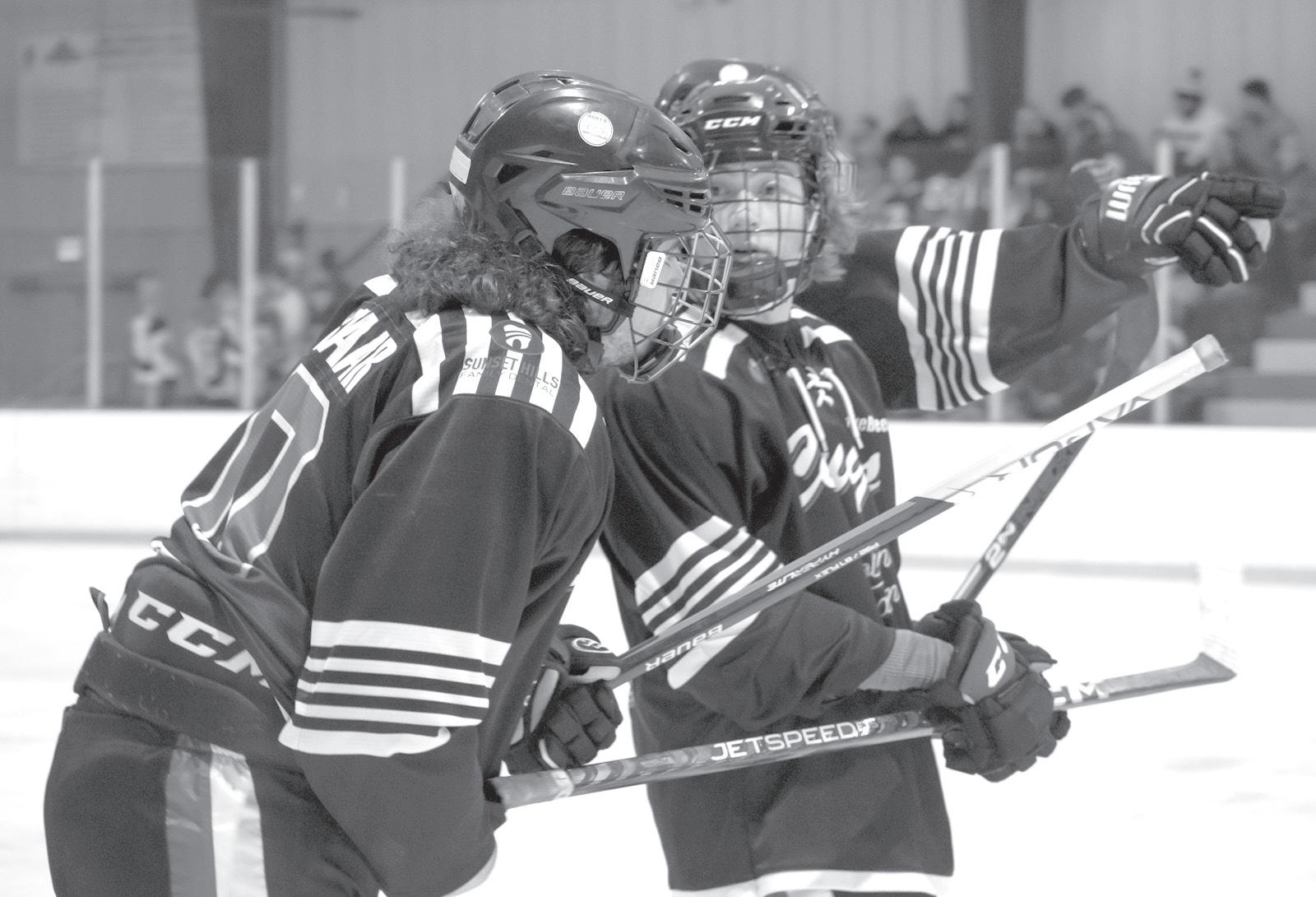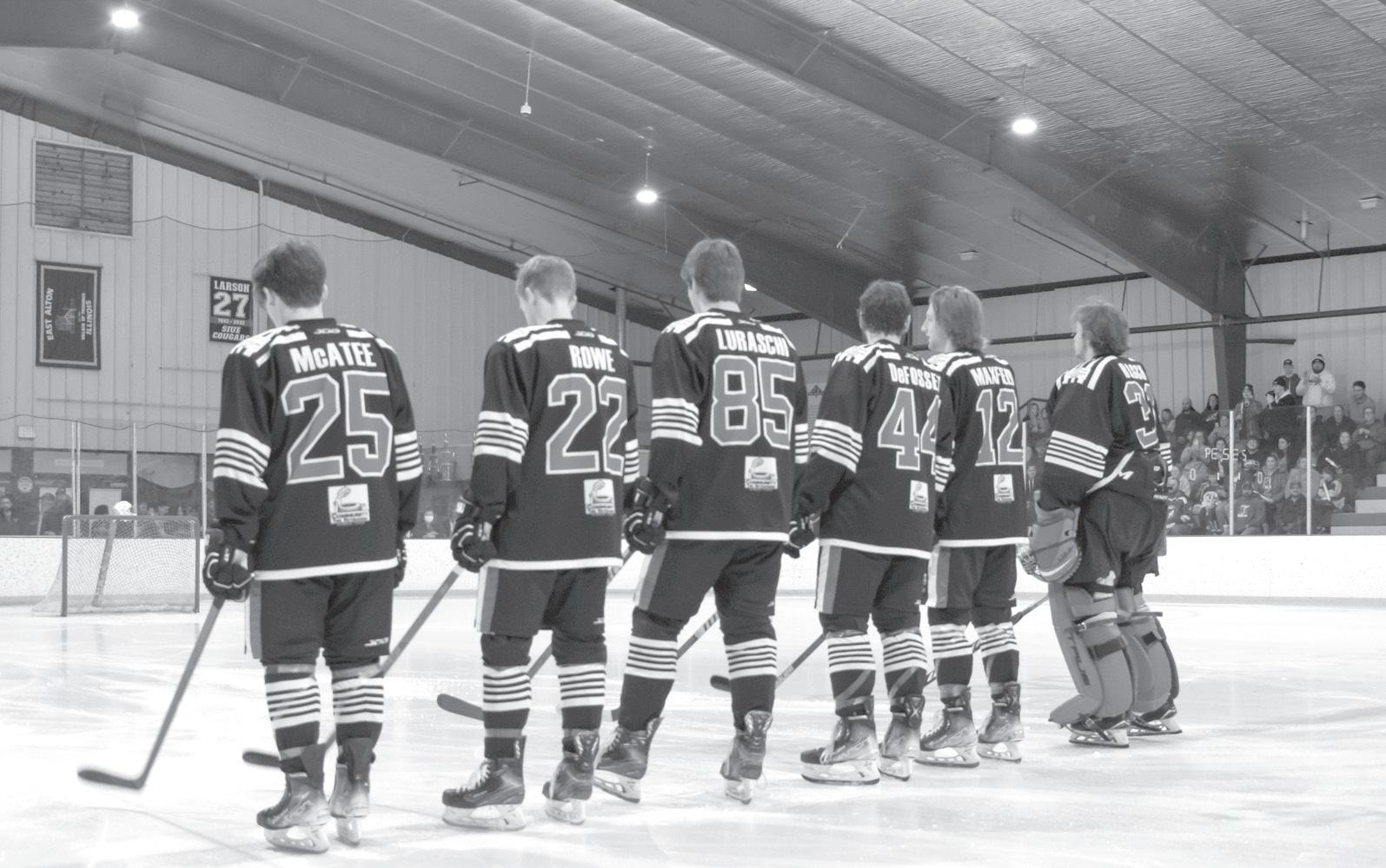LGBTQ+ faculty express hope for future of campus diversity
DYLAN HEMBROUGH reporter

Last semester’s campus climate survey revealed concerns and worries people of minority groups on campus held about their safety and identity.
Gary Hicks, a professor in the mass communications department and member of the LGBTQ+ community, said he once harbored some fear that his career would be stunted by perceptions of the LGBTQ+ community on campus.
“When I started here 25 years ago, my doctoral dissertation was on an issue involving the LGBTQ community, and I was very concerned whether I would have trouble getting a job,” Hicks said. “At no point was that ever an issue, so I’ve been very thankful to SIUE for providing, at least in my experience, a very open and welcoming community.”
Ezra Temko, assistant professor of sociology and member of the LGBTQ+ community, said it makes sense that survey respondents felt that the campus was more inclusive than the surrounding areas.
“The university [has] an extra layer of protection compared to the community,” Temko said.
Hicks said this “extra layer of protection” is likely due in part to SIUE’s status as a public university. However, even with this insulation from the surrounding areas, SIUE is not immune to homophobia and transphobia. Anti-trans stickers and vandalism of menstruation products in bathrooms have cropped up on campus.
Despite the offensive stickers and vandalism, Nick Niemerg, president and co-founder of the Queer Faculty and Staff Association, said the university has generally worked quickly to act on these incidents.
“I really do applaud the Facilities Management team for being so quick to respond to any of those acts of vandalism and taking care of it very quickly, so I think we’re moving in the right direction,” Niemerg said.
AROUND ONE-FIFTH OF STUDENTS SURVEYED IDENTIFY AS LGBTQ+
According to the survey, around 8 percent of faculty and staff identified as LGBTQ+, compared to 21 percent of students. Hicks, Temko and Niemerg all agreed that this trend is due in part to the current generation of college students being more aware and more understanding of LGBTQ+ issues.
“I think it’s a generational
effect. I think as Gen Z folks get older, I don’t think they’re going to stop being those identities,” Temko said. “I have an 8-yearold and I think that he’s being raised with a lot more understanding and exposure to what LGBTQIA+ is.”


Hicks said he was equally surprised and pleased at the percentage of students who identify as LGBTQ+, but that that statistic is indicative of wider trends within Generation Z, the current generation of college students.
Niemerg agreed, saying Generation Z is more “fluid” with how they identify.


“I think that speaks to the generation of students who are here. Gen Z students just grew up in more accepting environments, perhaps not at their home, perhaps not if they came from a small town, but once they come to the university,” Hicks said.
“That’s the real purpose of a university, is to not only educate, but part of that education is to surround yourself with people who are unlike yourself.”
Hicks said the 8 percent figure of LGBTQ+ faculty and staff likely does not reflect the real number, again, due to the environment in which they were raised.
“I would argue, going back to the faculty, that there’s more than 8 percent, and probably the reason they are not out is simply because of the generation in which they were raised,” Hicks said.

DIVERSITY IS NOT A ONEAND-DONE DEAL
While Hicks, Temko and Niemerg all agreed SIUE has provided a welcoming environment to members of the LGBTQ+ community, they also said there is still plenty of work to be done.
“When I first started here, diversity simply was about race, and that was it. It has been really an uphill climb to get administration to understand that diversity means so much more than race,” Hicks said. “In terms of continuing to truly embrace all forms of diversity — that is something the university has to continue actively working on.”

Hicks said the LGBTQ+ community has only recently been considered in diversity training compared to other marginalized groups, and should continue to emphasize a more inclusive form of diversity.
“When diversity is such an important issue, it is hard to see yourself being one of the least looked at groups,” Hicks said. “Especially when we have such a large number of students who identify as that, it really should shift the priorities of the univer-
sity administration who focus on issues of diversity.”
Temko said there are often good ideas around diversity, but that they can easily get caught up in bureaucracy and red tape.
“I would say that overall, I think that SIUE does want to welcome LGBTQIA+ students, staff and faculty,” Temko said. “However, I think that SIUE is often hesitant to take action if it might upset people.”
Temko said inspiration could be taken from SIUE’s antiracism task force in implementing a broad anti-oppression course for students, faculty and staff.
“I would love to see, like how we had the antiracism task force, a task force that really looks at SIUE structurally and systemically and says, ‘What’s going on in terms of our curriculums, what does language on forms look like, what are the ways that we are reproducing heterosexism and heteronormativity, [and] how can we challenge it?’ and then actually implement those things,” Temko said.

Temko also said one of the problems facing celebration of diversity is the lack of education on the various terms used to discuss these ideas.
“I think there’s a good segment of our university that doesn’t have even basic vocabulary or understanding of some of these issues,” Temko said. “So that’s a step, is to make sure they do have that information and knowledge.”
Niemerg said SIUE’s recognition of minority group associations has helped the university’s progress towards a more inclusive environment.
“When I started working here five years ago, I felt like I was the only gay person here because I didn’t know who else was here. So it’s nice that there is a group and I know I’m not alone,” Niemerg said. “That’s what these constituency groups do. They rally support around each other, and it makes you feel like you’re more a part of the greater campus community.”
As per the campus climate survey, the LGBTQ+ community of SIUE is generally satisfied with the promotion of diversity and inclusivity on campus. That said, diversity is not a one-anddone deal. Hicks said the university must continue to work to ensure the continuity of the diversity we have today.

“We always have to work,” Hicks said. “Any marginalized community is going to continue to have to work.”
The results of the SIU system campus climate survey can be viewed online.
follow the alestle @alestlelive See you on the Internet! @TheAlestle @Online Editor Alestle @thealestle the student voice since 1960 alestle THE Southern
Thursday, February 2, 2023 Vol. 76 No. 18 SIUE Alum returns to campus for public health degree PAGE 3 SIUE students share stories behind viral social media accounts PAGE 4 SIUE Hockey falls to Bradley University PAGE 8
Illinois University Edwardsville
@thealestle
NEWS IN BRIEF

Listening Session explores aftermath of Tyre Nichols’ death
Following the release of video footage of the death of Tyre Nichols, the Inclusive Excellence, Education and Development Hub hosted a listening session to give members of the SIUE community a place to share their thoughts.
Assistant Vice Chancellor for Inclusive Excellence, Education and Development Lindy Wagner, who facilitated the discussion, began the discussion by reminding attendees not to tokenize or single out BIPOC attendees.
“This is not an opportunity for our Black and Brown students to educate the uneducated,” Wagner said.
Jessica Harris, Vice Chancellor for Equity, Diversity and Inclusion said for her, it was an opportunity to take a pause and a deep breath in community with others who needed the same opportunity to process the events of the
past month. Attendees shared feelings in the aftermath of the video’s release that included fear, anger, disappointment and numbness. One issue brought up was campus police wearing ‘Back the Blue’ memorabilia.
Jessica Ulrich, director of Counseling Services, shared apps to block certain social media apps to avoid triggering content, and for self-care including Insight Timer, Calm, Headspace, Stop and Breath Relax. She also shared self-care strategies such as taking breaks from consuming news content, getting plenty of sleep, avoiding excessive alcohol and drug use and connecting with others through community or faith-based organizations.
Harris thanked attendees for listening to one another, and said moments of community like these are needed more often.
01.25.23
Knives were found in Evergreen Hall.

A debit card was found in the MUC.
01.26.23
An offensive sticker was found on the wall of a staircase in the 500 wing of the Cougar Lake Apartments. BIRT was notified.
01.27.23
A traffic accident was reported in Parking Lot 5H. A 3D printer was reported missing in the Engineering Building.
01.28.23
A hit and run was reported in Parking Lot 7.
01.30.23
A Samsung phone was found in the MUC.
Late music professor Jerald Bolen remembered by friends and family
DYLAN HEMBROUGH reporter
After his death on Jan. 8, 2023, retired professor Jerald Bolen is remembered as a grateful person, passionate about everything in his life from his music to his family.
Bolen was a percussion instructor at SIUE until his retirement in 2010, but he also taught at SWIC and at the high school level. John Korak, a trumpet instructor, said he first met Bolen in 1995 after starting at SIUE.

“Over the years together, performing concerts or talking about music in general … that’s kind of how our relationship started and how it deepened over the years,” Korak said. “I consider him a very good friend.”
Rick Haydon, professor emeritus with SIUE, said he first met Bolen through a mutual friend while Bolen was working on his master’s thesis. Haydon said that, as his friendship with Bolen grew, the two would collaborate on several musical projects.
“Jerry actually did a book and had these instructional tapes that went with it for teaching drummers and percussionists,” Haydon said. “I had a mini-studio with drum machines and synthesizers, and we sequenced a bunch of the lesson plan out of the book, and then I recorded him playing percussion and drums as examples for the book.”
Haydon said Bolen was always one to try new things with new technology, especially in the musical realm. Haydon said the instructional tapes he and Bolen recorded went on to be used by many of the late professor’s students.
“This was the ‘80s, and … Jerry was always really good about being on the cutting-edge and wanting to try out new stuff,” Haydon said. “I don’t know that anybody had done it then … when we did it, but now it’s everywhere. It’s all over the internet.”
Haydon also said Bolen had a special fascination with South American music, even traveling there and participating in samba festivals.
“He actually traveled to South America several times, just to study samba and bossa nova,” Haydon said. “He also had an extensive collection of South American
instruments, like drums, shakers, [and] all the other percussion instruments of South America. I would consider him an authority on that stuff.” He’d went down and actually became part of the samba festivals.”
Stephen Bolen, Jerald Bolen’s son, said his fascination with South American music was sparked by his time with the 5th Army band during the Vietnam War. Jerald Bolen grew up in Staunton, Illinois, and enlisted to join the Army band.
“He ended up spending Vietnam in Central America, particularly around Panama, playing a lot of state-sponsored tours of U.S. embassies in South America,” Stephen Bolen said. “So he’s always had a draw for Latin American percussion and Afro-Cuban percussion especially. He was fortunate enough to go to Cuba and Brazil to take part in that rich percussive history.”
Stephen Bolen said that, though his father never presented himself as a veteran, his time in the Army band left a lasting impression on him for the rest of his life. Later on, Jerald Bolen would take opportunities to go to Latin America to revisit the music he loved.
“He got to go to Cuba on an SIUE tour, I believe, and got to explore Afro-Cuban percussion,” Stephen Bolen said. “He did a sabbatical one year, when he was teaching at SWIC in Belleville, down to Brazil where he got to participate in Carnaval, so that was a tremendous opportunity for him to go back to his roots.”
Korak said his friendship with Jerald Bolen eventually grew to incorporate much of the Bolen family, including Stephen and Jerald’s wife, Sue. Korak said his musical relationship with Jerald Bolen complemented their personal friendship.
“Those relationships you have in music are apart from the relationship you have with the person, and those two can strengthen one another,” Korak said. “The more you get to know somebody musically, in many ways, the more you get to know them as a person too.”
Even outside of music, Jerald Bolen was remembered as a very encouraging and supportive person. No matter a person’s talent, whether or not it was music-related, Stephen Bolen said his father would always encourage them.
“As somebody who made music his life, he would talk a lot about how talented everyone was that he got to work with, and talents wouldn’t always necessarily be displayed musically,” Stephen Bolen said. “If it was music, that’s great, if it’s not he’d be there to listen and offer advice.”
Korak agreed with this sentiment and said Jerald Bolen’s passion for music extended into an overall love of life.
“For Jerry, it’s just the grace he showed as a human being,” Korak said. “He was grateful to be in music, he appreciated everything that music offered him in his life, he never took anything for granted, he was very passionate about it, he was always smiling, because he loved what he did, and he was able to share that passion and love with other people in a way that really benefited them.”
Korak summarized his thoughts on his late friend and colleague, saying he never had a bad thing to say about anybody.
“He always looked for the best in people,” Korak said. “He was a tremendous man, and a fine example for any of us to model our lives after.”
alestlelive.com PAGE 2 Thursday, 02.02.23
| Photo courtesy of John Brophy and Stephen Bolen
DYLAN HEMBROUGH reporter
Gabriel Msengi has returned to SIUE in pursuit of two master’s degrees — another step towards his ultimate goal of opening a primary care clinic in Tanzania.
Msengi started his journey at SIUE in 2013, where he earned his BS in chemistry, minored in biological sciences, and then went to Howard University for his PharmD. Msengi said his love for pharmacy grew out of a fascination with chemistry during his high school and college years.
“In high school, I had done a Walgreens-St. Louis College of Pharmacy Explorers Program. It was an eight to ten-week introductory program where they would take … 20 students to different Walgreens and learn about pharmacy,” Msengi said. “I switched over to chemistry [from biology], I think because I just like problem-solving, and there were always problems in chemistry to be solved.”
Msengi was born in Tanzania and later lived in Iowa, California and Illinois before moving to Washington, D.C. to attend Howard University.
“It was the first time I’d been on the East Coast,” Msengi said. “It was a different atmosphere as far as it being East Coast. A lot of the people are very business-oriented, business-structured, so I [thought] that was a huge difference. Let me try to learn how to grow and adapt in a different environment, let me see how that would feel, attending a whole different area, a whole different lifestyle, everything was different away from home.”
While working on his PharmD at Howard, Msengi said he was involved in Capitol City Pharmacy Medical Reserve Corps, where he got lots of hands-on experience in the pharmacy world.
“We served southeast DC, [and] it’s a lower-income area,” Msengi said. “[There were] different patients that haven’t been seen by different providers, who have issues with hypertension, diabetes, noncompliance [and] lack of vaccinations.”

Msengi said the Medical Reserve Corps would often partner with other locally-known organizations and government agencies to run medical outreach events, such as Distant Relatives, which provided feminine supplies and food to the community.
“The public health department would reach out to the medical reserve corps, say that
and grow as a business-minded person. So, after I graduated, I wanted to do a little more with those two disciplines.”
Furthering his education led Msengi back to SIUE to earn his master’s in both public health and business administration with a concentration in health care administration. While he works on his next degrees, Msengi said he also works as a pharmacy manager in St. Louis.
“It is extremely busy, but if a patient comes up and they’re not feeling too good, you want to just slow down and take their blood pressure,” Msengi said. “Sometimes these patients will not come back for a vaccine, so if you’re trying to prevent the flu and the spread of the flu, and they come in asking for a shot, sometimes you just have to give them that shot.”
Msengi said he tries to conduct his work in a way that is conscious of the patient’s background, which can often mean working across class or linguistic boundaries.
“We drop what we’re doing so we can help protect them, because they may not be going home to the best conditions,” Msengi said. “If they’re sick, they can easily spread that to other people. You really just want to make sure you can provide the best care to the most vulnerable population, because that population doesn’t have access to the resources that some may take for granted.”
After earning his next degrees and getting more experience in the field, Msengi said he wishes to pursue his dream of opening a clinic in Tanzania.

“It’s a lifelong goal of mine to open up a primary care clinic in Tanzania and have it staffed with dentists, doctors, pharmacists, a well-rounded team that would be able to provide those resources to patients back home,” Msengi said.
| Winter Racine / The Alestle
Although he originally attended SIUE in 2013, Gabriel Msengi has now returned to campus for another degree.
this population needs this type of service, say a hepatitis vaccination event,” Msengi said. “They would call us and there would be a registered pharmacist there and pharmacy students that would be able to provide those vaccines.”
Msengi said he was struck by the level of poverty in the nation’s capital – an experience that fuels his public health studies now.
“One time I was driving by all the major news networks, like CNN, NBC, and I saw homeless
tents outside their buildings,” Msengi said. “We were at the United States capital and you could see so much poverty and so many people that didn’t have access to healthcare. We had dental students that would come out and do oral exams, some of the nursing students would help out with blood pressure screenings, doing counseling, talking to them about their medications if they have questions, and just giving them more information about their overall health.”
Medical clinics showed Msengi not only the public health world, but also the business world. Msengi said he learned a lot about the logistics of running such an event.
“All that work was more so public health, and being able to run and manage that type of organization, there were a lot of business-focused attributes to that organization,” Msengi said.
“So that’s something I could use my pharmacy knowledge and desire to do public health
Msengi said his aspirations in Tanzania rest upon his work and preparation beforehand, both during and after college.
“Anytime you want to do something, you want to put your research in there. Do the work prior to making a step like that. I don’t want to speed the process,” Msengi said. “[I want to] take my time and truly know my craft for me to understand public health, understand how to go about obtaining grants, understand how different systems work, gonna take the next couple years to understand that, as well as work on my leadership and capabilities as a leader and as a manager before I go back home and start working on that clinic.”
alestlelive.com PAGE 3 Thursday, 02.02.23
NEXT WEEK: PAST, PRESENT AND FUTURE OF WEB RADIO AT SIUE
GABRIEL BRADY managing editor
Popularity and virality on social media are difficult to achieve, and even harder to maintain. However, some students at SIUE have found ways to capture that lightning in a bottle and keep it.

Chia Boxdorfer, a senior in mass communications, is one of these students. She is a member of the cosplay community; she puts on a costume and makeup and poses as a character or person from pop culture in photo shoots, short videos and at conventions. It was something she started while in middle school with her friends. She posts these videos and photos on Instagram and TikTok under the name Teakup.cos.
Boxdorfer said although she posts on both platforms, her TikTok has been the more successful page, with more than 20,000 followers. She started her Instagram around four
years ago, and the TikTok account a year after that.
“In the beginning it was pretty slow, like getting your name out there is a whole process,” Boxdorfer said. “But with Instagram it’s definitely been slower. With TikTok, it’s definitely more of a quick-and-fast build. I think the first year I had done it, at the end I had gained around 10,000 followers or so. Since then, I’ve been getting 5,000 to 6,000 followers a year.”
Another social media page that may be recognizable to the SIUE community is the SIUE Bulletin, an Instagram page by the same name. The account posts satirical headlines about campus news. After the sign in front of Prairie Hall was hit by a car, a post from the Bulletin showed a picture of the ruined sign, with text that said, “Upon seeing first flake of snow, Prairie Hall resident instantly forgets how to drive”

The page was originally a spur-of-the-moment idea from Morgan Jackson, a senior in computer science. However, now it’s also run by junior political science and mass communications double major Madison Sample.
“I think I had the idea for it and had the first post within a 24-hour span,” Jackson said.
“I was in the Engineering Building, I think, when I came up with it … I just had a goofy little thought, and was like ‘What if I posted this?’ I really like those sites like The Onion, Reductress. There’s tons of different ones that do all sorts of satire headlines. So I was like,‘What if I did something like that for SIUE?’”
Sample said although she started taking a more hands-on approach recently, she’s been helping Jackson run the account since the start.
ed the account, he sent it to me and a few friends,” Sample said. “Me and my fiancé were some of the first followers. Morgan has so many random Instagram accounts, we thought it was just another account he’d created that he would let fizzle out. But I thought it was funny. He started sending me the posts before he’d post them and I’d give my opinion on them. Slowly that transitioned into me writing the headlines you see on there now.”
Unlike the Bulletin, Boxdorfer said a lot of her work is solely hers.
“There’s a lot that happens behind the scenes. Obviously, I make most of the outfits you see, so hours upon hours go into that,” Boxdorfer said. “I’m very blessed that I have a job that gives me weekends off, so Saturdays and Sundays are really when I can get into the makeup, get in front of the camera, sew, do things like that.”
Although the length of time varies, Boxdorfer said all of her posts take full days of work. She said she’s currently working on one that’s taken more than 100 hours over four months. She explained her process using a recent cosplay of the popular video game character Kirby.
“It was 80 hours, put just into making it, as in troubleshooting, structuring, sewing, wig styling, makeup, all that,” Boxdorfer said. “Then, I had to film the videos, which can take two or three hours. And then, you have to export the video and edit them down, which can take another two to three hours. So by the time you’re seeing a video, around 90 hours could’ve gone into everything.”
Alternatively, SIUE Bulletin’s posts are much quicker and much more focused on timeliness, according to Jackson. He used the post about the Prairie Hall sign as an example.
“I went back up there for a photo [around 2 a.m.],” Jackson said. “The snow had just started, but it was worth it, because that has become one of our most successful posts by a lot. We gained over a hundred followers in one day.”
With their focus on jokes for the campus community, Sample and Jackson said they’ve both received generally positive feedback from the campus community. Both Sample and | via Chia Boxdorfer
“We’re really, really good friends. When he creat-
Jackson are members of the student government.
“[Former Student Govern ment Vice President] Nicole Burbach is the hugest fan of us, and so is [Student Gov ernment President] Rahmat Salau. When we do Student Government jokes, they get so excited,” Sample said. “Greek Life has been very positive, as well, for the most part, but that’s be cause we try not to be too mean to them. There are some posts that don’t do as well with them.”
Sample said they try to ensure the Bul letin’s jokes punch upward, not downward. However, despite sometimes aiming the jokes at those in power, Sample said the SIUE Bulletin has still received support from them.
“We try to avoid bashing any specific groups or clubs too much, because we don’t want to ostracize people. I like it when pages for things like the library and the Cougar Store follow us, which they do,” Sample said. “[Associate Director of Resident Life] Rex Jackson also follows us … and I know the chancellor has at least seen the account, specifically one of the posts about him.”
Despite the large amount of time Boxdorfer spends on her account, she said it will never be a career for her.
“For me, it’s a hobby. People ask if I would ever turn it into a job. I would not, most likely. It’s a hobby I’m very passionate about,” Boxdorfer said. “I’ve been doing cosplay for 10 years. It’s not something I see myself stopping doing soon. If it was up to me, the end goal is to go up on stage at the U.S. Cosplay Championships one day.”
Although Jackson initially created the SIUE Bulletin as a one-off joke, he does hope it can continue on beyond his graduation in May.
Sample said she will remain at SIUE for another year after Jackson, and also said she intends to keep running the account while on campus.
“We’ve been trying to take on new people,” Sample said. “I’ll be taking over the account next year, and I’m not good at
| via The SIUE Bulletin editing, like to make the little thumbnails we have. I’m good at the marketing and writing side of things, with my degree, but I’m not the tech-savvy one.”
Boxdorfer said the best advice to anyone wanting to start on social media is to find a unique concept that you love, and commit to it.
“Find your niche and go all in. I know people think ‘Oh, no one’s going to watch me, because there’s like a hundred other creators who do this,’ but you’re your own person, with your own unique style and ways to express yourself,” Boxdorfer said. “Find a niche and go all into it.”
Jackson said there’s room to experiment, but it’s also good to be prepared to take losses if you want to experiment.
“When people see the Bulletin, we’ve had the same alternating red-and-white text style for every headline,” Jackson said. “We’ve branched out a few times. One time, we tried out a Reel, and it didn’t do bad or anything … You can branch out your content a little bit, but make sure your content still appeals to the audience you already have, or you have to accept that you may have some losses if you want to change your content.”
To see Boxdorfer’s cosplays, visit her Instagram or TikTok pages, and for the SIUE Bulletin, visit their Instagram page.

contact the editor: lifestyles@alestlelive.com 650-3527
lifestyles alestlelive.com PAGE 4 Thursday, 02.02.23
Support the Girls SIUE joins homeless outreach project
AUDREY O’RENIC copy editor
Support the Girls SIUE joined area partners to help bring its services to people experiencing homelessness in an annual outreach event.

Project Homeless Connect is an annual, nationwide event that aims to bring service providers and people experiencing homelessness together to connect them to services and resources in their area. Madison County provides volunteers from different organizations to pick homeless individuals up from various shelters, organizations and churches and bring them to the event.
Alicia Alexander, director of Support the Girls Edwardsville and co-faculty sponsor of Support the Girls SIUE, said SIUE students are the main source of volunteer support within the organization. She also said the volunteers help sort and organize the donations, as well as measure the women for bra sizing.
“This really is a need in our community because people have a tendency to donate clothes and coats which is wonderful, but it’s hard to get these items that are very personal, and people don’t think about it as a need, but there is a great need for it,”
Alexander said. “It’s about dignity.”
Alexander said the event was an all-service day, where those in need were pampered as well as provided basic services.
“Food is provided, tips on housing, recovery counseling, and sometimes there will be a stylist that will cut their hair, sometimes there are dental people here that will clean their teeth, the Lions Club has been here to help them get glasses if they need them, flu shots. We get to do the Bra Room,” Alexander said.
Alannah Nelson, a sophomore from Collinsville, said Support the Girls SIUE donated new and gently used bras, brand-new underwear and menstrual hygiene products.
“I think this is a really cool volunteer experience because there aren’t a lot of
opportunities to get new bras, new underwear and especially feminine hygiene products,” Nelson said.
LaRae Bigard, a junior from Newton, said she saw many mothers picking up bras for their daughters.
“It’s an underserved need,” Bigard
said. “I think it’s a really personable thing that we can help people with.”
Stephanie Batson, co-faculty advisor of Support the Girls SIUE, said that the group initially began with the donation of bras, but has since branched out into the donation of feminine hygiene products as well. She said they began to make “Period Packs” using donated Ipsy makeup subscription bags.
“Inside a Period Pack is enough, hopefully, for one month… it’s kind of like a nice thing to keep in a backpack or purse,” Batson said. “There are pads, tampons, liners and then we do little encouraging notes or stickers so they know it came from Support the Girls.”
Support the Girls held a “Period Packing Party” in the fall, where student volunteers came together to pack menstrual hygiene facts and learn more about Support the Girls’ initiative. Alexander said she got involved herself after her friend started Support the Girls in Washington D.C.
“I really thought her initiative was really neat and I decided to do it too, so I collected bras from neighbors and friends. I had a ‘Bra-beque’ and I cooked barbeque food for people and said to bring bras,” Alexander said.
Support the Girls goes beyond Project Homeless Connect, donating and volunteering all across the metro-east.
“We donate to anyone that needs [bras, underwear and menstrual hygiene products]… We donate them to nurses, foster care programs, anti-sex trafficking organizations, domestic violence shelters, homeless shelters, pantries, anybody who needs them,” Alexander said.
For more ways to volunteer, visit Support the Girls’ Facebook page.
REVIEW: ‘Five Easy Hot Dogs’ is a sad release from a talented musician
BRUCE
Mac DeMarco’s new album, “Five Easy Hot Dogs,” misses the mark in many ways and is an overwhelmingly boring and forgettable slog to listen through.

DeMarco, an indie musician from Duncan, Canada, is more often known for the rock-inspired roots shown on his previous albums such as “2” and “Salad Days.”
With DeMarco’s most recent project, “Five Easy Hot Dogs,” he goes in a completely different direction from all of his previous albums.
This is not always a bad thing, as an artist has to take chances and experiment with new things in order to grow.
A good example of this is Tyler Okonma, better known as Tyler, the Creator, who transitioned from a harsh sound with dark and borderline psychotic lyrics to a much brighter sound with emotionally vulnerable lyrics.
Okonma’s “Cherry Bomb” served as the transition album between his old and new sound, and remains one of his more di-
visive projects because of some of the directions that he took with the sound.
Okonma shows a successful pivot in direction as an artist, while DeMarco’s attempt just falls completely flat and doesn’t offer him much opportunity to grow.
Each song is named after a city where DeMarco live-recorded it. An example of this is “Chicago” and “Victoria.”
The album is also entirely instrumental, which is another big departure from the zany and introspective lyrics of DeMarco’s older songs.
The instrumental tracks mirror the lo-fi genre in their sound, but they all miss some of the core aspects that make lo-fi enjoyable. Soothing, dreamy sounds are present on the album, which are characteristic of lo-fi, but the lack of varied instruments makes it seem more like white noise than anything else.
The use of the same few instruments — likely because the album was recorded entirely on the road — is one of the biggest reasons the tracks are so forgetful. Because so few are used, they all mush together into one big song.
This makes the naming scheme of the songs confusing, as despite being named after different cities, they are all almost identical in sound. They all could have been named after the first song, “Portland,” and there would have been no difference at all.
All of this coming from DeMarco is disappointing. He has the ability to create good songs, as was seen in some of his earlier work, and yet this album hardly reflects that.
DeMarco’s older albums all have an identity to them. Each song is memorable in some aspect. Whether it be his guitar or his lyrics, something always stood out.
“Ode to Viceroy,” a song from “2,” is about DeMarco’s favorite brand of cigarettes. This song has such a unique identity through its slow yet piercing guitar. The lyrics are almost bittersweet, as DeMarco talks so happily about his smoking even though he knows that it’ll kill him one day. Just these two elements, the guitar and lyrics, make it so distinct to DeMarco.
This is completely lost in “Five Easy Hot Dogs.” There is not a single song on this al-
bum that can be identified for its unique sound or even really be tied to DeMarco. Each song is something that you’d listen to while doing chores to forget where you are, not something you’d listen to so you can feel any
emotion besides apathy.
If you want to listen to DeMarco, choose any other album besides this one. “Five Easy Hot Dogs” doesn’t show the talent that DeMarco has when it comes to making music.
alestlelive.com PAGE 5 Thursday, 02.02.23
DARNELL sports editor
| Thea Weltzin / The Alestle
Volunteers sort through donations preparing for the event, meant to provide those in need with hygiene products. | Winter Racine / The Alestle
EMILY STERZINGER Editor-in-Chief
KIRSTEN O’LOUGHLIN Graphics Manager

ELIZABETH
DONALD
JANA HAMADE AUDREY O’RENIC
WILLIAM
HAVE A COMMENT?
Let us know! opinion@alestlelive.com
Campus Box 1167 Edwardsville, IL. 62026-1167

LETTERS TO THE EDITOR POLICY:

The editors, staff and publishers of The Alestle believe in the free exchange of ideas, concerns and opinions and will publish as many letters as possible.




Letters may be submitted at The Alestle office: Morris University Center, Room 0311 e-mail: opinion@alestlelive.com
All hard copy letters should be typed and double-spaced. Letters should be no longer than 500 words. Include phone number, signature, class rank and major.
We reserve the right to edit letter for grammar and content. Care will be taken to ensure that the letter’s message is not lost or altered.
Letters to the editor will not be printed anonymously except under extreme circumstances. We reserve the right to reject letters.

The name Alestle is an acronym derived from the names of the three campus locations of Southern Illinois University Edwardsville: Alton, East St. Louis and Edwardsville.
The Alestle is published on Thursdays in print and on Tuesdays online during the fall and spring semesters. A print edition is available every other Wednesday during summer semesters.
For more information, call 618-650-3528. For advertising, email advertising@alestlelive.com.
alestlelive.com

Cougar Controversies
78%
Do you like snow? yes! no!
22%
Questions go up at 10 a.m. every Monday on Twitter: @TheAlestle
Student employees keep SIUE running

During the last boil order, Starbucks continued operating with a limited menu, and the dining hall managed to serve students anyway. For that, we should thank our student employees.
As of 2023, the university employs approximately 1,100 student workers in positions including service, sales, clerical and technical jobs. That’s a huge workload, and one that can be easy to take for granted.
Even outside of circumstances like a boil order, student employees, particularly those in food service, deal with chaotic lunch rushes that tend to include loud, long lines. Many are in-
viewternational students and do not speak English as a first language. Nevertheless, they help us grab a meal or make a Starbucks run between classes, without which many of us would be lost.
Yes, sometimes they mess up an order or the lines get longer than we would like. That can be frustrating in the moment, but given the loud music and crowds, perfection would be ridiculous to expect. Besides, if people weren’t willing to do these jobs, there would be no Starbucks or Auntie Anne’s orders to mess up.
In our residence halls, resident assistants and desk managers help students with daily needs such as swiping in as well as more difficult personal issues that arise
while living on campus. RAs sometimes have to handle roommate troubles, mental health emergencies and domestic disputes. Desk managers often work long hours so residents can return late at night. While they are paid an hourly wage and are compensated for room and board, these jobs can be incredibly taxing.

Other student workers answer phones, work in the facilities management program or in the library. One thing they have in common is the extra time spent on campus. While other students get to go home or leave campus for work, student workers don’t have that kind of separation between work and school. Sure, this may be convenient, but we should
recognize the contribution they make to our campus to keep things running smoothly.
As journalists, we often report on novel events or recognizable names, since that’s what tends to make a story newsworthy. However, it’s important to remember that it’s the everyday operations that keep SIUE running. They may not make headlines, but they’re an essential part of the SIUE community.



Our student workers balance their jobs with the typical stressors of college life. Let’s remember to be polite and patient with them. Greet them with a smile, stay off your phone while ordering, say please and most importantly, thank you.
Like Greta Thunberg, you can make a difference
activism revolves around climate change-she began when she was only 15.

nominated for four times. She is also the youngest person to win TIME Person of the Year.
Sometimes it can feel like the world will never change, but young people continue to prove that wrong.
As students we can vote, protest, and we can advocate for things we believe in. Advocacy is one of our most powerful tools.
An activist is someone who takes action on an issue that can be political or social that they care about.
Student activists have been doing the work for years. During the civil rights movement, the Student Nonviolent Coordinating Committee organized several peaceful protests and sit-ins to fight for what they believed in. Even though the work was dangerous, they made a difference.
A more modern activist would be Greta Thunberg, whose
According to Britannica, she started a sit-in at Sweden’s capitol building as an attempt to make Swedish lawmakers address climate change. Even though she began the sit-in alone, more people joined her each day.

Thunberg’s sit-in also inspired people across the world to participate in strikes.
Even though she started out with a small act, Thunberg has traveled across the world for the last five years giving speeches and attending protests to inspire others to care about climate change as much as she does.
Now at the age of 20, Thunberg has continued her work and has been nominated for and won several awards. One of her biggest nominations is the Nobel Peace prize which she has been
Just like Thunberg, we too can make a difference. All it takes is one small action.
Start by finding something you are passionate about. It could be a social issue that impacts a minority or a political problem revolving around a law.
Then educate yourself on the topic. Find information from a trusted online source, a book or from someone directly impacted by the topic.
Once you know enough about the topic, share it. Post about it on your social media or tell someone why they should care about it.
Although knowledge and spreading the word are important, showing up to support your movement is even more critical.
Find a protest, or organize
one, and continue spreading the message. Another way to get involved is by joining a group. Look for an online group or a campus club that might be involved with your chosen issue.
As college students this one might be difficult, but if you are able to, donate. Find an organization or a group that you align with and help fund them. Sometimes there are scams, so just make sure your donations are going to a trustworthy organization or group. A good way to check if the organization is a scam is through Charity navigator.



Change only happens when people come together. Advocacy helps create a larger community of like-minded people who might be able to make that change.
Just like Thunberg, all it takes is one small act to make a difference.
Share your thoughts: opinion@alestlelive.com 650-3527
WEEK: IT’S OK TO BE SINGLE ON VALENTINE’S DAY
NEXT
OPINION
THE ALESTLE
STAFF editorial board
DAMIAN MORRIS Multimedia Editor
PAGE 6
NICOLE BOYD Online/Opinion Editor
GABRIEL BRADY Managing Editor
BRUCE DARNELL Sports Editor
CHLOE WOLFE photographer
BANKS Copy Editors TAMMY MERRETT Program Director UDIT NALUKALA Circulation Manager AMINA SEHIC Offi ce Clerk ANGIE TROUT Offi ce Manager DYLAN HEMBROUGH CAMELA SHARP Reporters WINTER RACINE CHLOE WOLFE Photographers THEA WELTZIN Illustrator
FRANCESCA BOSTON Lifestyles Editor
Thursday, 02.02.23
AQUARIUS (Jan. 20 - Feb. 18)
Today is a 7 — Slow for tricky sections. Physical barriers block your way. You could receive conflicting advice. Take time to assess the situation and choose your best path.
h r sc pe
PISCES (Feb. 19 - March 20)
Today is a 7 — Keep your patience, especially with romance. Expect the unexpected. Misunderstandings abound. Practice finding humor in unlikely places. Discover love hiding in plain sight.
ARIES (March 21 - April 19)
Today is a 7 — Household issues require attention. Avoid tense or awkward situations by fixing something before it breaks. Extra patience pays with family. Include comfort foods.
TAURUS (April 20 - May 20)
Today is an 8 — Get good advice. Read the words of philosophers and poets. Misunderstandings or delays could frustrate creative projects. The rules may change. Reinforce basic structures.

GEMINI (May 21-June 20)
Today is a 9 — Stay cautious with spending; there may not be as much as you think. Unexpected expenses could drain. Avoid risky business. Maintain steady cash flow.
CANCER (June 21-July 22)
Today is an 8 — Your self-confidence could waver, facing a personal challenge. Ignore rumors, gossip or negative chatter. Reconnect with a sense of purpose or a dream.
LEO (July 23 - Aug. 22)
Today is a 6 — Find a peaceful spot for private planning and organization. Review and adapt budgets and schedules. Don't overextend. Rest and recharge. Consider the big picture.
VIRGO (Aug. 23 - Sept. 22)
Today is a 7 — Social challenges could frustrate or get awkward. Avoid automatic reactions. Notice, observe and listen to what's going on. Misunderstandings abound. Offer to help.
LIBRA (Sept. 23 - Oct. 22)
Today is a 7 — Professional obstacles or surprises could require adaptation. Slow down and focus to finish faster. Take care with your work. Patiently simplify. Imagine dreamy results.
SCORPIO (Oct. 23 - Nov. 21)
Today is an 8 — Find a nice view for a rest stop. Monitor conditions and reassess your route and itinerary. Obstacles may block your investigation. Discover unexpected possibilities.
SAGITARIUS (Nov. 22 - Dec. 21)
Today is a 7 — Contribute to shared accounts. Avoid controversy or gossip. Financial discussions could get heated. Don't throw your money around. Quietly maintain a positive balance.
CAPRICORN (Dec. 22 - Jan. 19)
Today is an 8 — Actions speak louder than words, especially with your partner. Do what you said. Avoid arguments or fuss. Find unusual solutions. Work behind the scenes.
alestlelive.com PAGE 7 Thursday, 02.02.23
NANCY BLACK HOROSCOPES: FEBRUARY 2
SIUE Hockey freezes against Bradley University

 JANA HAMADE copy editor
JANA HAMADE copy editor
The crowd waved glow-in-thedark sticks to cheer on the SIUE hockey team Jan. 20 at the East Alton Ice Arena, which ended in a close loss to Bradley University.
The game was neck and neck until the end of the third quarter, which concluded with a 4-4 tie. The five-minute playoff period was also a close call, with Bradley University scoring a goal in the final minute, bringing the score to 5-4.
Christian Perry, a senior forward on the team from Peyton, Col-
orado, said that hockey is a game of mistakes.

“If you make a mistake you’ve got to make sure they don’t happen again, so it’s kind of important that you work as a team and cohere together and make the least amount of mistakes,” Perry said.
Perry said events like the Glow Game bring in everybody. He said that events like this or the teddy bear toss is when the team has had their most exposure. The teddy bear toss allowed fans to bring a stuffed animal that the team then donated to local organizations.
“I think putting up special games
like that is going to be the best opportunity to bring in more students,” Perry said. “There was a pretty big crowd, so I think this, and the teddy bear game was another big one.”
Daniel Verhaar, sophomore forward from Troy, Illinois, said that if they all work together as a team and keep the energy up, that they can finish high on the stat sheet.
“If we play like we did before this last game and keep the mistakes to a minimum, I mean we can come off with possibly a bye in the playoffs, and I mean we just gotta keep working the way we were before today,” Verhaar said.
The team’s Head Coach Tyler Elbrecht said that he thinks the team played
well overall but that they’ve got to learn how to close out games.
“I think we need to figure out playing a full 60 minutes. I think we played hard hockey, we played good hockey, but this time of year we need to play a full 60,” Elbrecht said. “I think the turnout was awesome. We had probably 700 people so we did a good job about spreading the word about games, so we’ll just continue to do that.”
The team plays their next game against Saint Louis University on Feb. 3, 2023.
contact the editor: sports@alestlelive.com 650-3527 SPORTS alestlelive.com Thursday, 02.02.23 PAGE 8 NEXT WEEK: LESSER KNOWN SPORTS CLUBS AT SIUE
SIUE hockey players line up at the start of the game. | Winter Racine / The Alestle
SIUE players discuss their next move. | Winter Racine / The Alestle Junior Defensemen Drew Larose from Edwardsville, Illinois. | Winter Racine / The Alestle







































 JANA HAMADE copy editor
JANA HAMADE copy editor

